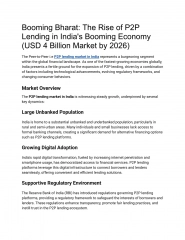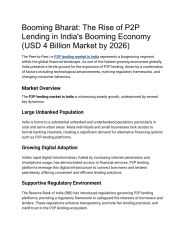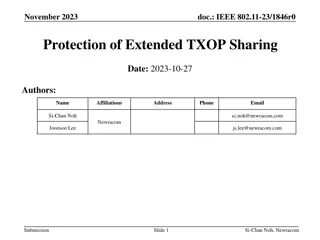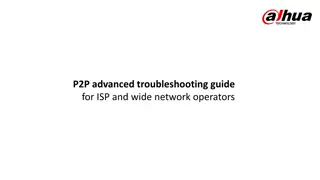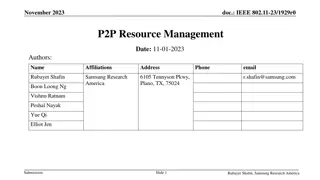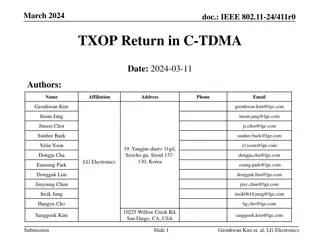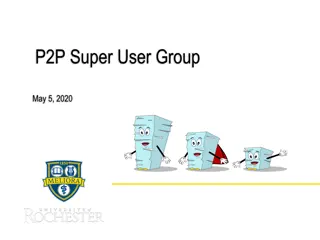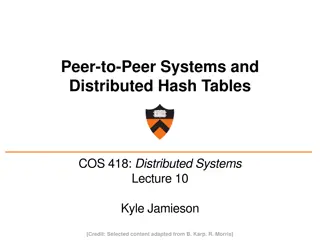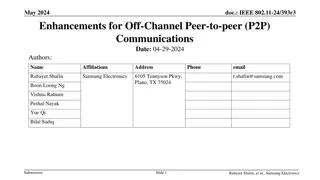IEEE 802.11-20/1938r8 TXOP Sharing for MU P2P Communication
The document discusses the IEEE 802.11-20/1938r8 standard and proposes mechanisms for an Access Point (AP) to facilitate peer-to-peer communication between stations (STAs). It introduces the concept of triggered TXOP sharing to enhance latency performance and spectral efficiency in scenarios involving multiple peer-to-peer links. Deployment examples illustrate how future advancements in the 11be extension can optimize resource allocation for efficient communication among devices connected to the same AP.
Download Presentation

Please find below an Image/Link to download the presentation.
The content on the website is provided AS IS for your information and personal use only. It may not be sold, licensed, or shared on other websites without obtaining consent from the author. Download presentation by click this link. If you encounter any issues during the download, it is possible that the publisher has removed the file from their server.
E N D
Presentation Transcript
June 2021 Doc.: IEEE 802.11-20/1938r8 TXOP Sharing for use in MU P2P Date: 2021-06-25 Authors: Name Jay Yang Affiliations Nokia Address Phone email Zhijie.yang@nokia-sbell.com Prabodh Varshney Mika Kasslin Lorenzo Galati Giordano Gang Cheng Yiming Jiang Dingjun He Submission Slide 1 Jay Yang, et al. (Nokia)
June 2021 Doc.: IEEE 802.11-20/1938r8 Content 11be has agreed that the 802.11be amendment will have mechanism(s) for an AP to assist a STA to communicate with another STA and one of them [1] provides means for an AP to share time resource obtained in a TXOP for peer-to-peer frame exchanges This one mechanism builds upon the use of a MU-RTS TXS Trigger frame that allocates time within a TXOP for transmitting one or more non-TB PPDUs Further improvements in latency performance can be achieved with additional mechanisms with which an AP could allocate resources of its TXOP for multiple simultaneous peer-to-peer frame exchanges In this presentation, we discuss the case of triggered multiuser peer-to-peer and propose the 11be to consider this extension as a R1/R2 feature Submission Slide 2 Jay Yang, et al. (Nokia)
June 2021 Doc.: IEEE 802.11-20/1938r8 Deployment example with 11be features Four Wi-Fi smart phones (STA1, STA2, STA3, STA4) and two Wi-Fi equipped smart glasses (G1, G2) connect to the same AP. Locally stored contents are streamed from the smart phones (STA1, STA2) to the smart glasses. Simultaneously, STA3 and STA4 are used for cloud services through the AP. Today s approach: Peer-to-peer communication like TDLS may be used between the smart phones and the smart glasses for direct streaming Tomorrow s approach with triggered TXOP sharing (already agreed in 11be): The AP may allocate a portion of its obtained TXOP for use in one peer-to-peer link Benefits: coordination of the P2P communications Tomorrow s approach with more advanced 11be support: The AP may allocate a portion of its obtained TXOP for simultaneous use in multiple peer-to-peer links Benefits: further improving latency performance and spectral efficiency especially in dense deployment cases Submission Slide 3 Jay Yang, et al. (Nokia)
June 2021 Doc.: IEEE 802.11-20/1938r8 Exchange sequence Frequency STA1,G1 tuning the channel to the first 20MHz STA2, G2 tuning the channel to the second 20MHz 20Mhz Second ACK MU-RTS TXS TF duplicated PPDU(STA2->G2) CTS (G2->STA2) 20Mhz MU-RTS TXS TF (RU1=STA1,Target RX: G1-AID, RU2=STA3, Target RX:G2-AID) ACK First PPDU(STA1->G1) CTS (G1->STA1) SIFS SIFS SIFS TXOP Note: RU is allocated in 20MHz(242 tones),40MHz,80MHz, etc. manner, which is aligned with PHY adjacent channel rejection(ACR). Submission Slide 4 Jay Yang (Nokia)
June 2021 Doc.: IEEE 802.11-20/1938r8 Proposal Building upon the following two motions [1] that have passed in the 11be The 802.11be amendment shall define mechanism(s) for an AP to assist a STA that communicates with another STA. 802.11be supports defining a procedure for an AP to share time resource obtained in a TXOP for peer to peer (STA-TO-STA) frame exchanges. Whether it is in R1 or R2 is TBD. We propose to define a mechanism for an AP to transmit a frame (TXOP MU Sharing frame) that shares resources of an obtained TXOP for two or more simultaneous peer-to-peer frame exchanges The AP assigns resource units (RU) to individual non-AP STA pairs for use in peer-to-peer frame exchange and indicates those assignments in the transmitted TXOP MU Sharing frame together with the allocated portion of the obtained TXOP. TXOP MU Sharing frame may need to solicit CTS or alike in uplink before any peer-to-peer frames can be exchanged. Submission Slide 5 Jay Yang, et al. (Nokia)
June 2021 Doc.: IEEE 802.11-20/1938r8 Summary In this proposal, we have discussed the benefits of a procedure with which two or more simultaneous peer-to-peer frame exchanges may be facilitated by an AP We propose that the 11be defines such a procedure e.g. as an optional extension of the triggered SU procedure currently under discussion in the TG Submission Slide 6 Jay Yang, et al. (Nokia)
June 2021 Doc.: IEEE 802.11-20/1938r8 SP1 Do you support that 11be defines a mechanism for an AP to allocate one or more portions of its obtained TXOP to multiple associated STAs via a single MU RTS TXS frame under the Triggered TXOP sharing procedure in R2? Results: Y/N/A Submission Slide 7 Jay Yang, et al. (Nokia)
June 2021 Doc.: IEEE 802.11-20/1938r8 References [1]: https://mentor.ieee.org/802.11/dcn/21/11-21-0087-06-00be-pdt-mac- triggered-su.docx Submission Slide 8 Jay Yang, et al. (Nokia)


